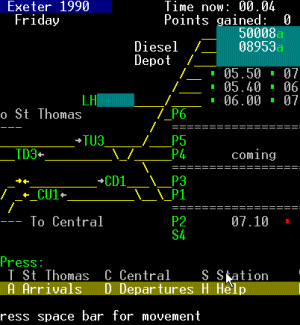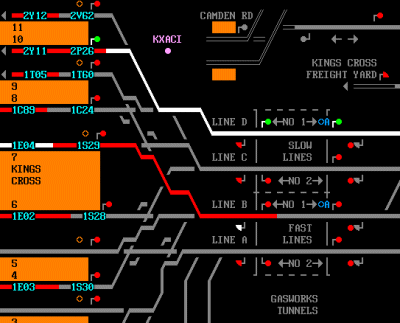
Some years ago, I decided to switch over from playing with trains on the computer (see Railway Software) and have a go at building a "proper" N-scale model railway layout.
- Layout design concept
- Layout construction
- Track
- Model railway electronics
- The turntable
- Software
- Scenery
- General thoughts
- Details
- Category: Railways
The work of the signal operator or dispatcher takes place largely on the computer screen nowadays, so it should be an ideal part of railway operations to simulate. Not surprisingly, there are some very interesting and challenging examples out there. These are just a small selection.
1 siam
My personal favourite for a long time were the dos-based simulations from siam. Don’t let yourself be put off by the world’s oldest user interface (remember Turbo Pascal and ascii graphics?): these are very cleverly designed, addictive programs. Purists may disapprove, as they don’t attempt to simulate the detailed working of a signal panel, but add variety to the exercise by putting you in charge of preparing and selecting the right locos for trains, as well as controlling train and shunting movements. Most of the simulations are British-based, covering a wide range of periods, but they also do a few set in the us and continental Europe.
They will run on anything that can run dos, including Virtual pc on the Mac (they also have Amiga versions). I still play them occasionally. Main drawback: they are expensive for DOS software! Try the demos available on their site.

2 pc-Rail
The pc-Rail simulations focus more on the detail of power-box operation: you control all the individual signals on a classic nx-type panel. They are very interesting, but perhaps a little less fun than the siam simulations - I find that I don’t play them very much once I’ve learnt how to get through the timetable.
You can get additional timetables for all the simulations, and - also for a fee - a timetable editor to create your own.
3 Simsig
The authors of these programs have gone over to writing training simulators for real signallers, and are now offering the existing Simsig simulations as free downloads for private use. Like pc-Rail, they focus on realistic simulation of what the signaller actually sees, in this case on the latest iecc signal panels. A nice feature is that several of the panels incorporate Automatic Route Setting (ars) which takes care of the routine train movements, leaving you free to concentrate on dealing with problems.

4 Stanicar
This is a Czech signal simulator that includes utilities for building your own control areas and timetables. A bit like Train Dispatcher, but freeware, and with a rather better interface. It’s still under development, and the documentation is a bit patchy, but probably worth a look.
http://flint.vlaksim.com/indexEN.php
- Details
- Category: Railways
Economic simulations tend to have less emphasis on the technical details of building railways and driving trains, but put you in the position of an entrepreneur trying to build railway lines and run trains to make profits from the passengers and goods carried. A few classic examples:
Railroad Tycoon
This is something of a classic. Quite believable in the 19th-century scenarios when you’re building lines to open up the North American outback, but a bit less so when it comes to the modern world, and especially to urban settings.
Traffic Giant
Probably the most “technical” that I have come across — this is an urban transport simulation, where you have very detailed control over the schedules, routes and stops of your trams, buses, and metros. A nice feature is that the inhabitants of your city are simulated individually, and have very specific, predefined transport needs — if you don’t provide a bus route to their place of work, shopping area, or whatever, they will go by car and create traffic hold-ups. A disadvantage of this system, however, is that it doesn’t allow for urban development in response to your transport services. Providing a remote village with a fast service to the city doesn’t make anyone go to live there, it just leads to empty trains. Similarly, demolishing property to build new tracks reduces the number of passengers available.
Locomotion
This is written by Chris Sawyer, who was responsible for the original Transport Tycoon and Roller-Coaster Tycoon games. It’s fun in that you get to run all sorts of different transport modes: trucks, buses, trams, trains, planes, ships. Tracklaying is by snapping predefined shapes together, exactly as in Roller-Coaster Tycoon, which is less comfortable than some other games, but reasonably intuitive after a while.
- Details
- Category: Railways
This - loosely defined - category takes its starting point from the idea of a model railway layout. At one extreme are programs that are little more than cad tools for planning layouts to build in the real world; at the other powerful 3D simulation tools.
1 Trainz
The Australian Trainz seems to be somewhere between msts and the “virtual model” category. I wasn’t impressed with the demo of the original Trainz, which was definitely more model than simulator. However, it's still going strong, and they seem to release new versions at regular intervals, improving all the time. Unlike most other rail software, they produce versions for the Mac and even the iPad.
- Details
- Category: Railways
Cab simulators are programs that put you in the position of the train driver. You have to drive your train along a certain route, complying with the signals and speed restrictions along the way, and try to get to your destination on time.
1 Zusi
Although primarily a cab simulator, Zusi does have some characteristics of a network simulator. You can drive any of the trains on the route, change cabs when you reverse, etc. Its main strength is a very detailed representation of German signals and safety systems. The untextured graphics look a bit primitive at first sight but by keeping things simple graphically, the program is able to run fast enough to be useful on quite modest hardware. The demo only allows you to drive on one route, but if you order the full version you get a cd with dozens of other routes (mainly German) and all the documentation and tools you need to build your own routes and stock. Like Rail3D and bve, it’s essentially a one-person project supported by an active user community.
Update 2015: Zusi 2 is still supported, and still distributed by CD, which now costs about €20 (depending on where you are and how you pay). There is an advanced version called Zusi 3, but at present that is only available as a professional training tool. A hobby-version is promised.
2 bve
This Japanese freeware program is a simple, fixed-viewpoint cab simulator. The graphics are quite impressive - people writing routes can optimise the scenery to take advantage of the fact that the viewpoint moves along a fixed line, and keep objects very simple. The problem is that it has rather short-term ‘play value’ - there are only very limited possibilities for variation within a route, so once you’ve driven a given route two or three times, you will be starting to get bored with it.
It’s a bit of a palaver installing it, as the program’s author, ‘Mackoy’, only supplies the bare minimum of English translations, but probably worth at least a look. A quick search on the web for “bve” will throw up a few sites with more detailed English instructions, information on building routes, etc.
BVE home site (bilingual gb/jp)
3 Real Railway
Similar to bve in look and feel, but uses video clips of real Japanese railway journeys. You can download it, or play it online using Flash if you have a broadband connection.
http://www.realrailway.com/en/index.html
4 Mechanik en 57
This Polish dos freeware program is similar in approach to bve, although the graphics are very low-resolution. The train dynamics feel much more realistic, though.
English-language download site
5 Spoorsim
October 2005: It looks as though this project has been abandoned. A pity!
Just for a change, this program is South African in its focus, although the author, Charl Vockerodt, seems to live in the uk. It seems to be an attempt to build an msts clone with more realistic steam loco dynamics. At the moment (early 2005) it’s still in a very early stage, with two locos driving round an endless test track in generic veldt scenery, but the graphics look very good.
http://homepage.ntlworld.com/slsim/
6 Microsoft Train Simulator
msts was for a long time the heavyweight in the world of rail simulation, and it still has its enthusiasts, long after disappearing from the market.
Unlike most earlier cab simulators, an msts route is a complete 3D environment. You can move out of the cab to watch the train pass from the trackside, or follow it from a ‘helicopter’ view. You can also take different routes at junctions, shunt wagons into sidings, and so on, all of which makes train driving that much more interesting. There is a very detailed simulation of train dynamics, and quite a convincing representation of steam loco controls. Just a pity that you have to do it all with the keyboard…
As well as the six routes supplied on the msts cd, there were dozens of commercial and freeware routes on offer from third parties, at least some of which were much better than the msts originals. There is also plenty of third-party rolling stock available.
7 Open Rails
Free software MSTS clone, which takes advantage of the huge base of MSTS content available and seems to have added all sorts of new features. Still Windows-only, unfortunately.
8 Railworks Rail Simulator (or "Train simulator" - they don't seem to know which)
The commercial successor to MSTS, marketed under various confusingly similar names, and running under Steam (appropriately enough). Still basically the same idea as MSTS, but of course the graphics are much more sophisticated. The latest version is TS2015.
- Details
- Category: Railways
Subcategories
Page 3 of 4
